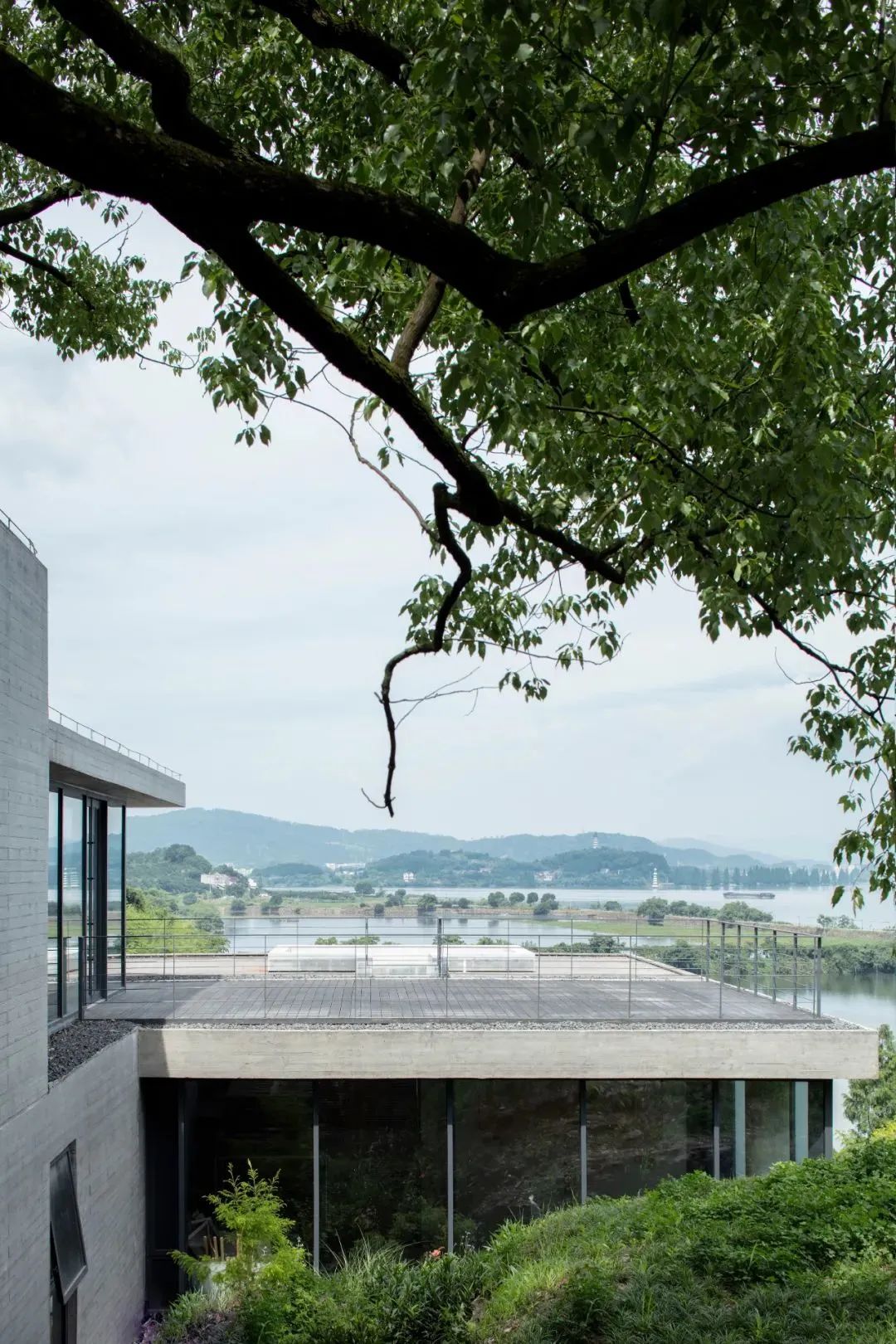With thick rock mountains and undulating slope terrain, when facing different interfaces, the architect hopes to maintain a simple and pure space form, gently touch the environment, and show an intriguing close relationship between the building and the environment.
In this way, the design of “double entrance” is also the flexible coping strategy of architects when the owner’s function is not clear.
“Fishing village teahouse” is located here.
△ glass curtain wall mapping landscape scene Photo: Chen Xi △ rolling mountains fill the indoor blank space Photographer: Zhao Yilong △ outdoor landscape scene and indoor blank space Photo: Zhao Yilong – other possibilities of local materials there are multiple considerations in choosing concrete to build such a public building in a rural environment.
The continuous glass curtain wall limits the internal space, each space intersperses with each other, and finally forms an indoor and outdoor space form.
Firstly, the concrete material is most consistent with the designer’s overall design strategy.
The ground elevation of the top floor is flush with the back mountain and connected with the village.
△ entrance space of courtyard on slope Photo: Zhao Yilong △ wall extension at the entrance Photo: Zhao Yilong △ entrance space of the courtyard on the slope Photographer: Chen Xi △ Photography: in Tao Tao’s clear physical relationship, the height of the architectural space changes in an orderly manner, giving freedom to the internal space.
△ buildings embedded in mountains Photography: summer solstice △ buildings and mountains bite each other Photo: Zhao Yilong – the multi-storey building site with reduced volume is located at the intersection of Fuchun River, Lan River and Xin’an River, embracing the three rivers, watching Wulong mountain, looking at the twin towers and reflecting the mountains and rivers.
The shape of the folk houses, whether in plane, facade or indoor and outdoor decoration, are obviously similar to those in southern Anhui and northern Jiangxi.
△ facing the scenery of Sanjiangkou with mountains and rivers Photography: the summer solstice design uses the terrain height difference to divide the two functions of teahouse and reception into primary and secondary retreating buildings extending in line with the terrain, which not only weakens the building volume visually, but also produces a large number of terraces with first-line river scenery.
The entrance on the slope is made into a circular yard, which extends through a wall to spread the space to the surrounding, blurring the boundary between the building and nature.
Photography: Summer Solstice architectural design gad × line+ Project location Zhejiang, Hangzhou completion time Building area in 2020 2463 square meters “traditional sloping roof, scattered layout, rural materials and wood construction technology are the habitual choices of architectural creation in the current countryside.
The scenery defined by the new town is: the tea house of the fishing village, -gadxline+ fan, who is nestling under the old trees.

△ activity platform Photo: Chen Xi’s main building near the river and the secondary building on the slope have holes respectively, and plants are introduced as entrance tips.
The visitors turned several times under the far-reaching cornice, and their sight changed between the river and the mountain staircase.
△ Material texture and light shadow Photo: Zhao Yilong △ material texture and light shadow Photographer: Chen Xi △ material texture Photography: Chen Xi’s choice of concrete as a one-time molding material is also a test of the depth of architectural design and construction cooperation.
△ Waterfront Road Photographer: Chen Xi △ architectural form Photography: the main building of the building is stacked and retreated at the summer solstice, which is unfolded layer by layer in the form of sheet mass.
The typical characteristics of the buildings are green bricks and white walls.
The bottom floor is connected with the Waterfront Road through two layers of rubble masonry gray space, which effectively reduces the interference of pedestrians to the use space.
△ Up along the extended platform Photography: Chen Xi △ clear architectural hierarchy Photography: he Yaliang ascended the steps along the rubble masonry slope protection.
As a material with a strong sense of involvement in the natural environment, it can achieve a balance with the overall modest volume strategy of the building; The unique texture of wood formwork gives the concrete a texture close to the human body, adding a trace of interest and richness to the minimalist material selection.


△ conceptual sketch △ site △ The village style base around the site is located in a mountain depression, facing the Sanjiangkou scenery with a line of Tianshui and vast waves.

In order to ensure the continuation of the concept, the architect integrated the indoor landscape design, uniformly embedded the lamps, switch panels and wires in advance, and also designed the landscape seats, embedded handrails, drains and other details at the entrance.

This may be another possibility of architectural style in the landscape environment of Jiangnan under the background of constantly calling for “local materials”, “traditional symbols” and “Orientalism”.
△ dialogue interface with mountain rocks Photography: summer solstice △ relationship between architecture and site Photography: he Yaliang (Part 1) landscape is not only the starting point of spatial organization, but also an organic component of space.
The building is close to the mountain and facing the water, and the white camp in the space deliberately creates a special artistic conception.
Wu Daogang is an interested person and shares what he is interested in.
The horizontal extension of the soothing platform and the continuous climbing along the mountain also bring people two different body perceptions.
The large overhanging floor slab is not only an extension of the mountain, but also a natural activity place.
Therefore, the design choice is presented in the form of layers that eliminate the volume, and the interest of mountain and water viewing is introduced into the architectural space experience with ingenious moving line design.
As the name suggests, it is to create a good place to taste tea in the water village with mountains and water and misty rain.

Because there is no ceiling, in order to hide the pipeline and air conditioning outlet, three concrete sandwich wall systems with different thicknesses of 400mm, 600mm and 1000mm are designed for different parts of the building, corresponding to three functions: insulation layer, pipe well and equipment cavity.
△ aerial photography of the site: he Yaliang △ conceptual sketch △ shape evolution △ overall shape model photo △ cantilevered floor slab Photography: the summer solstice main building is actually three floors.
△ Climb the mountain stairs Photographer: Chen Xi △ steps near the mountain Photo: Tao Tao (left) summer solstice (right) △ riverside steps Photography: the summer solstice environment is the established condition for the existence of buildings.
Architects hope to strengthen the purity of space through the careful treatment of structural equipment.
△ top texture Photo: Meng fanhao △ wood formwork concrete texture Photography: Chen Xi △ wood formwork construction process Photography: Meng fanhao △ relationship between building and site Photo: Architect Zhao Yilong imagined that when the construction activities were over, lush plants would gradually cling to the concrete wall and roof in a warm and humid environment.
The official account has been banned from the official account.
Some small villages are scattered around the site.

The scheme does not pursue a focused visual image, but maximizes the building volume hidden in nature, just like growing out of a depression, and maximizes the landscape interface of the building at the same time.
△ concrete sandwich wall system (used for insulation, pipeline and equipment in turn) △ Pure interior space Photographer: Zhao Yilong △ embedded handrail Photography: Summer Solstice – the construction and implementation of the project has lasted nearly three years since the design, and the design work runs through the whole construction process..
In order to ensure a better landscape view, the whole building volume is hung from high to low.
On the other side of the river is the Millennium ancient town Meicheng, where the ancient Yan state capital is located, and the Huizhou culture flows from Xin’an River.
The river water, cloud shadow, rolling mountains and faintly visible villages in the distance constitute a vivid ink painting.

If we want to make the building really become a part of the landscape, we must rely on the power of time to fit the site for a long time.
The space was sometimes open and sometimes quiet.
Facing the typical landscape environment in the south of the Yangtze River, we explore another possibility of architectural style in the landscape environment in the south of the Yangtze River through the digestion of volume, rethinking of materials and deep intervention in construction.” ——Meng fanhao △ fishing village teahouse dissolved in the landscape photography: Jiande on the summer solstice, a county-level city under the jurisdiction of Hangzhou City, Zhejiang Province, was a place of Baiyue in ancient times, with a long history, beautiful mountains and rivers and numerous water systems.



